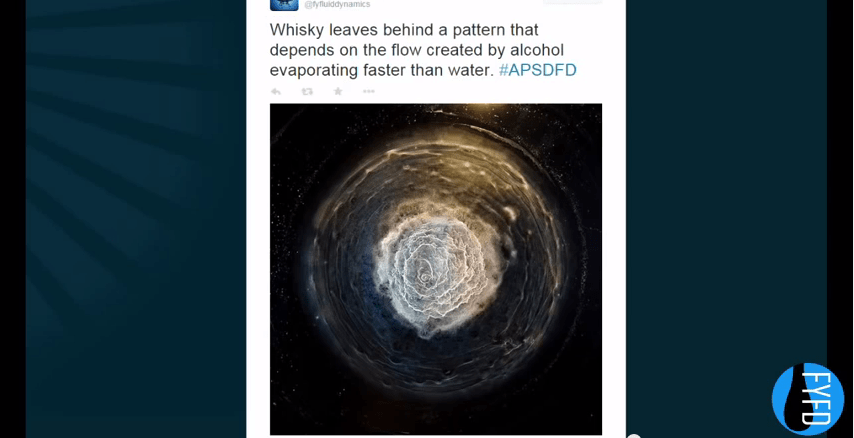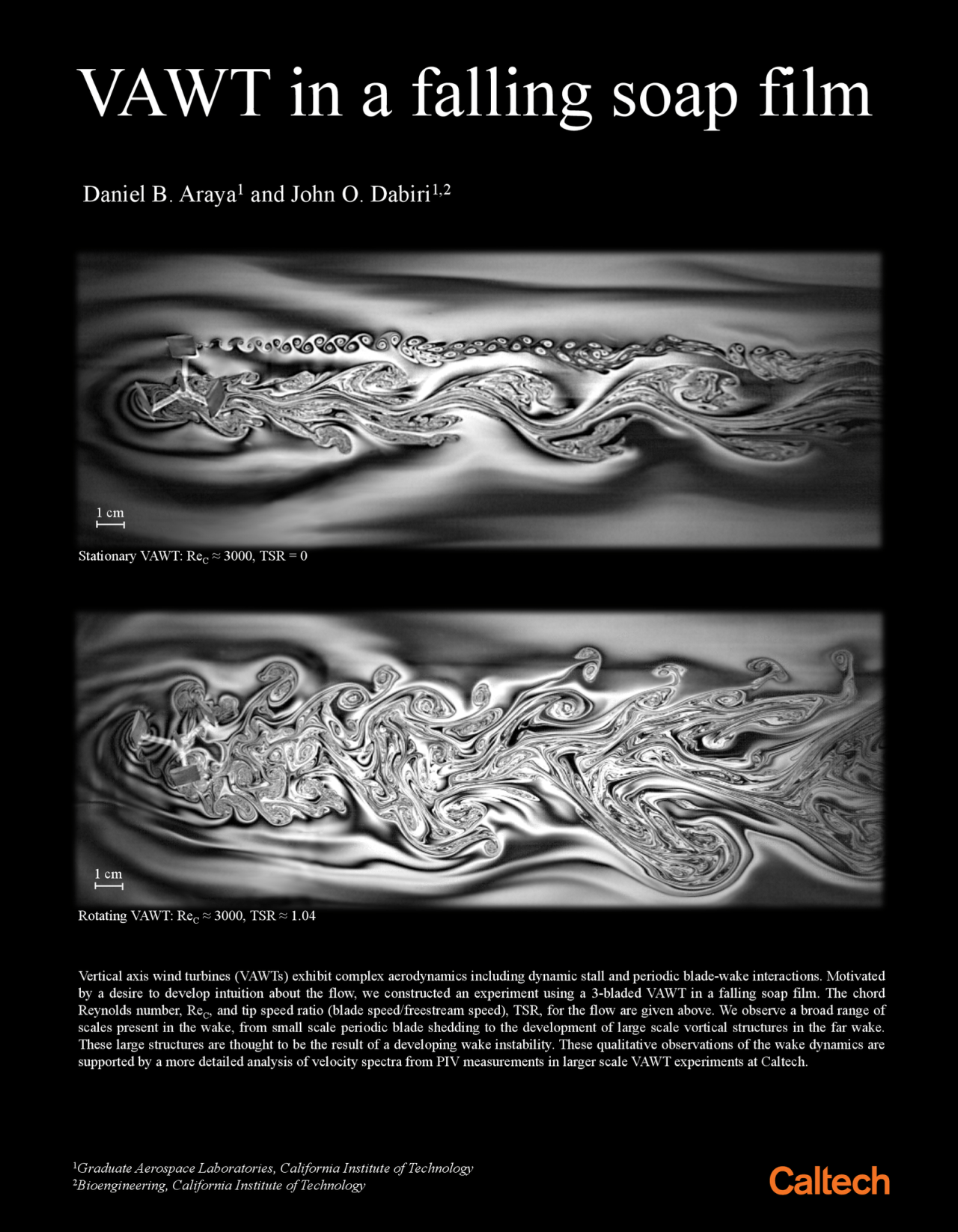Like many flows, flames can be unstable and undergo a transition from orderly laminar flow to chaotic turbulent flow. The timelapse image above shows the propagation of a flame front travelling downward. Each blue line represents the forwardmost position of the flame at a specific time. The flame is essentially two-dimensional, held between two glass plates separated by a 5-mm gap. The V-like points in the flame front are called cusps, and if you look closely, you can see cusps forming and even merging as the flame moves downward. Also notice how the flame front is more uniform near the top of the image, but, by the bottom, it has split into many more cusps. This is one of the indications that the flame is unstable. Check out the full poster-version of the image in the Gallery of Fluid Motion. (Photo credit: C. Almarcha et al., original poster)
Tag: APS DFD 2014

Frog Tongues and Parrot Laser Safety Goggles
What do frog tongues, whisky, tattoos, and parrot laser safety goggles have in common? They’re all a part of the latest FYFD video! Check out my behind-the-scenes look at the biggest fluid dynamics conference of the year and find out what science everyone was talking about. (Image credits: N. Sharp, source video)

Behind the Science
FYFD features lots of science, but this new video gives you a chance to see the scientists, too! It’s a behind-the-scenes look at the American Physical Society Division of Fluid Dynamics meeting that took place in San Francisco recently. You may recognize some of the stories, but I guarantee there’s new stuff, even if you were there! Special thanks to everyone who helped me make the video; I had a blast doing this. (Video credit: N. Sharp)

Vertical-Axis Wind Turbines
Vertical-axis wind turbines (VAWT) are an alternative to traditional wind turbine designs. Unlike their more common cousins, VAWTs rotate about a vertical axis and are omni-directional, meaning that they do not have to be pointed into the wind to produce power. While their size allows VAWTs to be packed much closer to one another than traditional turbines, a clear understanding of the flow around the turbines is needed in order to place the turbines for effective and efficient operation. The images above show the complicated and turbulent wake of a three-bladed VAWT when stationary (top) or rotating (bottom). The flow is visualized using a gravity-driven soap film (flowing left to right in the images) pierced by a model VAWT (seen at the left). The wakes contain many scales from simple, periodically-shed vortices off a blade to very large-scale vortical structures forming downstream of the turbine. This work originally appeared as a poster in the Gallery of Fluid Motion at the 2014 APS DFD Annual Meeting. (Image credit: D. Araya and J. Dabiri)
Cavitation
[original media no longer available]
Cavitation–the formation and collapse of vapor-filled cavities within a liquid–occurs in a variety of natural and manmade applications. It can shatter bottles, wreak havoc with boat impellers, is used as a hunting mechanism by several shrimp species, and can even generate light and sound. It is the collapse of the cavitation bubble that can be so damaging, and this video shows how. In the experiment, researchers generate a cavitation bubble near the free surface–or, in other words, near the air-water interface. Pressure in the bubble is much lower than the pressure of the surrounding liquid, so the bubble collapses after the momentum from its initial generation is spent. Interaction with the surface generates a jet that projects downward and pierces the cavitation bubble as it collapses. As seen from 0:54 onward, the bubble’s collapse generates a shock wave that propagates outward from the bubble site. It’s this shock wave that so effectively damages materials and stuns underwater prey. (Video credit: O. Supponen et al.)

Crown Sealing
Objects falling into a liquid pool create a beautiful splash, and, in this beautiful, award-winning video, the Splash Lab explores a peculiar instability that occurs just as the splash closes. The buckling instability they describe involves distinctive ridges that form along the splash’s ejecta sheet as it domes over and closes. The number of ridges depends both on the object size and the liquid’s properties. (Video credit: J. Marston et al.)

Sound Interactions
Sound waves often interact with many objects before we hear them. Understanding and controlling those interactions is a major part of acoustic engineering. The animations above show shock waves–sound–from a trumpet interacting with different objects. The sound is made visible using the schlieren optical technique, allowing us to observe the reflection, absorption, and transmission of sound as it hits different surfaces. Fiberboard, for example, is highly reflective, redirecting the sound waves along a new path without a lot of damping. In contrast, the metal grid is only weakly reflective and a small portion of the incoming sound wave is transmitted through the grid. To see more examples, check out the full video, and, if you want to learn more about acoustics, check out Listen To This Noise. (Image credits: C. Echeverria et al., source video)

Wave Clouds

Coming home from APS DFD, I looked out the window as we flew east over the last of the Rockies and caught these wave clouds. Air flowing west to east gets disturbed by the mountains, which creates internal waves in the atmosphere. Generally, these are invisible–though they can cause some of the turbulence you feel when flying. In this case, water vapor has condensed at the crests of the internal waves, creating a pattern of cloudy and clear stripes to mark the waves. The internal waves damped out by the time we flew a couple hundred miles east of Denver, but for awhile conditions were just right. (Photo credit: N. Sharp)

Piazza del Popolo
The lions of the fountain in Rome’s Piazza del Popolo eject a turbulent sheet of water. Random fluctuations in the water sheet cause holes to form. Driven by surface tension, these holes grow and merge, leaving behind ligaments of water which quickly break up into a spray of unevenly-sized drops. (Image credit: E. Villermaux)

APS DFD 2014
It’s that time of year again! Sunday marks the start of the 67th Annual Meeting of the American Physical Society Division of Fluid Dynamics. I’ll be in San Francisco for the full conference. On Sunday at 15:30 ET/12:30 PT I’ll be co-teaching a workshop on science communication alongside Flora Lichtman, David Hu, Rachel Levy, and Jason Bardi. We’ll be live-tweeting the event with the hashtag #DFDSciComm, and you are welcome to join in with comments and questions, even if you’re not attending the workshop in person. We’ll do our best to answer.
For those coming to the conference, keep an eye out and come say hello. I’ve got special FYFD stickers for those who do.
I expect to do some photos and short updates from the conference here, but for up-to-the-minute info on what I’m up to, your best bet is to follow the FYFD Twitter account. See you in California! (Image credits: N. Sharp/FYFD)
















